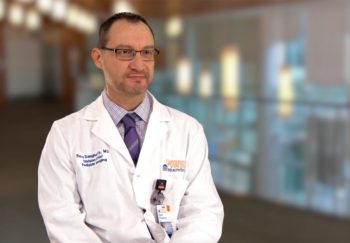Interventional radiologists perform minimally-invasive, image-guided procedures, meaning they operate by making only a tiny cut or inserting a small needle into the skin. This reduces the patient's pain and recovery time.
Interventional radiologist Luke Wilkins, MD, and his colleagues treat a variety of conditions, including:
- Diseases of the arteries and veins, such as varicose veins and peripheral artery disease
- Abdominal aortic aneurysms
- Liver disorders
- Kidney disorders
- Cancer
Get to Know A Charlottesville Interventional Radiologist
We asked Wilkins to answer our 7 Quick Questions.
1. Why did you become a doctor?
I knew I wanted to work with people in an education/service capacity, and I really enjoyed my science courses. This seemed like a natural fit.
The ultimate deciding factor was when I was working in a steel factory, and one of the other guys on the line said I should go to med school because I’m “not that dumb” (his words).
I’ve always thought you should take advice where you can get it and applied the next year.
2. Why interventional radiology?
I enjoy the creativity of interventional radiology. It’s exciting working in a space knowing that you’re on the cutting edge of medicine, creating new treatment techniques, and minimally invasive therapies. The ever-evolving field allows a large amount of research opportunities.
I also get to help a wide variety of patients (oncology, peripheral vascular disease, varicose veins, etc.) through all the different organ systems and pathology we are involved with.
3. What’s one thing about your specialty that might surprise people?
Many of the procedures that were commonplace 10-20 years ago are now rarely performed. Likewise, what we’re doing in another 10-20 years is likely to be markedly different than what we do currently. The field is constantly changing, given the rapid technological changes.
4. What’s the most exciting research happening in your field right now?
I may be biased, but the research around novel therapies for liver cancer is very exciting. There is so much that we do not know about the blood supply to tumors and the changes that occur as a result of the therapies we provide.
Here at UVA, we are developing novel therapeutic techniques that take advantage of the cellular changes that occur during our procedures. We’re using those changes to our advantage to increase the efficacy of our treatment. This will improve the response to treatment and give our patients a longer, better life.
5. Where did you grow up?
Adrian, Michigan
6. Who is your inspiration or hero?
I guess I would say that my dad is my biggest inspiration. He is a retired high school math teacher and one of the hardest working people I know. He treated his students with respect and kindness and was always ready with a joke.
Replacing Conventional Surgery
Interventional radiologists treat a variety of conditions, including uterine fibroids, peripheral artery disease, and thyroid nodules.
7. What’s your favorite thing about working at UVA?
The people who work here are invested in the institution and committed to seeing it improve. There aren’t a lot of healthcare providers at UVA that are “just passing through” or using the institution as a stepping stone to a different career point. Rather, they see UVA as their home and actively work to provide a comprehensive healthcare experience for their patients.
When a healthcare provider views their institution as their permanent home, it encourages them to look at their colleagues in a different light. We view each other more as teammates rather than as providers on different services. This allows us to focus on the best outcomes for patients and improve the quality of our care.
One of the things that brought me to the University of Virginia after I finished my training, was the collaborative nature of the physicians here. We have very talented, very intelligent physicians from all specialties. And one of the things I noticed when I first came here is that everyone works together for the care of the patient.
I say first and foremost, my passion in medicine lies in patient care. Getting up every day and being able to help patients either achieve a better lifestyle, a better quality of life, or just provide them more time with their loved ones, is really what brings me to work every day.
If you're a new patient and you're coming to see me, I hope that you can expect to be treated with kindness and compassion, and more so than that, I try every day to educate my patients so that they know exactly what their condition is, exactly what their treatment options are, so we can reach a decision together.

